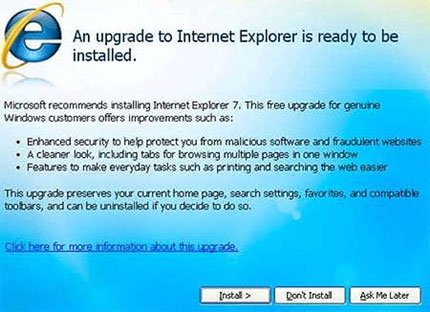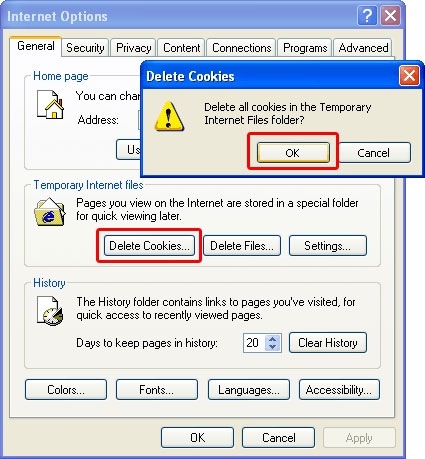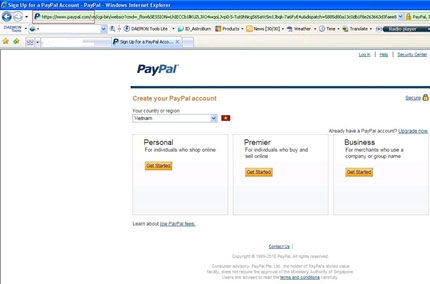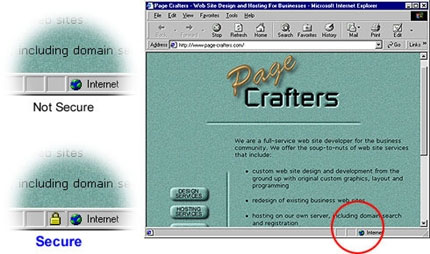4 ways to surf the web more safely with IE
Find out some ways to help you not worry every time you browse the web with the Windows browser.
Surprisingly, basic security and security measures are 'ignored' when users want to search for information or browse the web quickly and save time. Therefore, if you are a regular user of Internet Explorer to read the news or search for documents, you will have to be careful with the potential dangers.
Here are some basic measures that can help you 'defend yourself' when using Windows' default web browser program (IE).
1. Update, update and continuously update

Microsoft is constantly offering security patches and upgrades for all its products, including Internet Explorer. The reason is simple, there is no completely safe or 'immune' program for viruses and Trojans, only potential dangers can be detected and repaired promptly.
To complete its pet Web browser, Microsoft has tried to update patches for important security holes. Therefore, to ensure the safety of web surfing, users should not 'lazy' upgrade Internet Explorer.
2. Set up Internet Zone

By setting up a custom Internet Zone, users can meet all their personal needs while ensuring PC safety when surfing the web. Each zone is defined as a group of websites or regions on which these websites are set up and your level of trust in them. Zone settings available in Internet Explorer 8 version include:
- Local Intranet: Websites placed on your local network. These sites do not need an Internet connection to access
- Trusted sites: A list of websites that you absolutely trust and think they do not have any risk to your computer.
- Restricted Sites: A list of websites that you know or know about information about safety or danger.
- Internet: All websites are not included in the three categories mentioned above.
By customizing Internet Zone, you can set up IE activity by default whenever you visit a website that is part of the above 4 sections. So, how will Internet Zone protect you?
When you select a website group, you can change the security level. Corresponding to each level, IE will prevent or allow dangerous behaviors to take place or not. For example, displaying a pop-up window, not automatically downloading files .
3. Cookies limits

Cookies are meant to be small data files stored on your computer and contain necessary information about a particular website. A cookie can be used to store user ID, password, personalization preferences, usage habits, and access history.
For example, if you go to a website where you have to choose a language, Cookies will save the settings and do not force you to choose the next time you 'visit'. Although it may sound convenient, Cookie is more dangerous than you think.
Specifically, you cannot know which cookies are being used or stored on your computer by the website. And therefore, you also cannot determine which cookies are safe and dangerous. In the default mode of Internet Explorer, Cookies are allowed to be used with all websites except those located in Restricted Zone.
However, to limit the download and storage of cookies, you can go to IE, on the Tools Menu, select Internet Options and click on the Privacy tab. Then, drag the slider to choose the security level and set the custom as you like. In addition, you can select settings for each individual website by typing the address into the Sites box or manually configuring using Custom Level.
If the risk of dangerous Cookies has entered your computer, proceed to delete them by going to IE / Tools / Internet Options / General / Temporary Internet Files and pressing the delete button.
4. Check the encryption level of a website before filling in the information

When surfing the web, you should pay attention to the encryption level of a website. Encryption is understood as the method that website owners use to protect sensitive information such as user names, passwords, addresses, phone numbers or even credit card numbers.
Therefore, if the website you are visiting does not use any encoders, it means that the information you use or fill will become a good bait for hackers and conspirators. bad.

There are 2 ways to help you check this out. (Note that you should use the latest version of Internet Explorer). The first way is to pay attention to the yellow lock screen below the status bar of Internet Explorer. The second way is if the website link has https, it is equivalent to having a secure website.
You should read it
- Link download Tor Browser 10.0.7
- Awareness and experience - the most important factor in every network security process
- How to create WiFi hotspot on UC Browser web browser
- Edge lets you turn off annoying notifications
- Experience the Yandex Browser of Russia
- Face point 15 the safest web browser for Android
- Chrome browser first surpassed Internet Explorer
- Anonymous browsing: can protect your privacy
May be interested
- 10 ways to protect you online
 every day you surf the web, you may not know that there are countless stalking threats to steal passwords, personal accounts, or 'eat' out your data completely. there are 10 ways to avoid worrying.
every day you surf the web, you may not know that there are countless stalking threats to steal passwords, personal accounts, or 'eat' out your data completely. there are 10 ways to avoid worrying. - Top 5 best IP fake software
 fake ip, change ip helps you surf the web safely, not being recognized by your presence. at the same time it also helps you to access web sites as well as online games blocked ip addresses in vietnam. there are so many fak software
fake ip, change ip helps you surf the web safely, not being recognized by your presence. at the same time it also helps you to access web sites as well as online games blocked ip addresses in vietnam. there are so many fak software - Cloudflare's new DNS 1.1.1.1 service, more secure, faster web surfing
 cloudflare unveiled a new dns 1.1.1.1 service with a response time of only 14ms and impressive security, promising to provide users with a more secure and high-speed internet surfing option.
cloudflare unveiled a new dns 1.1.1.1 service with a response time of only 14ms and impressive security, promising to provide users with a more secure and high-speed internet surfing option. - Surf the Web safely and privately with the Cocoon utility
 there are several add-ons that help keep your online connection safe and protect your privacy. for those who prefer a simple automated setup method, cocoon is really a convenient extension for them.
there are several add-ons that help keep your online connection safe and protect your privacy. for those who prefer a simple automated setup method, cocoon is really a convenient extension for them. - Suggestions 5 ways to treat armpits effectively and safely
 penetration usually occurs quite commonly at different ages and genders, here are 5 suggestions to help you treat the armpits very effectively and safely.
penetration usually occurs quite commonly at different ages and genders, here are 5 suggestions to help you treat the armpits very effectively and safely. - How to use LinkSafe to safely shorten links
 to shorten links, you currently have many different support tools for you to choose and use, and linksafe is one such service.
to shorten links, you currently have many different support tools for you to choose and use, and linksafe is one such service. - How to use VPN Gate to fake IP, hide IP, surf the web without blocking
 fake ip is always one of the first thought solutions whenever you need to access a website or online game but that service is blocked in vietnam. i will continue to show you how to use vpn gate - specialized software to fake ip, hide ip, help surf the web without worrying about being blocked.
fake ip is always one of the first thought solutions whenever you need to access a website or online game but that service is blocked in vietnam. i will continue to show you how to use vpn gate - specialized software to fake ip, hide ip, help surf the web without worrying about being blocked. - How to jump Vent safely, jump safely Vent in Among Us
 if you want to use vent safely in among us, please refer to the content in this article. because there are little things that you do not know about the sewer system in among us.
if you want to use vent safely in among us, please refer to the content in this article. because there are little things that you do not know about the sewer system in among us. - How to unlock SURF game on Edge Chromium Canary
 on edge chromium canary, the game surf is hidden. so how to reopen this title.
on edge chromium canary, the game surf is hidden. so how to reopen this title. - Things to do to 'stay healthy' on Windows 7 after the operating system has been killed
 windows 7 has officially been retired, marking the end of an era that is ingrained in the minds of millions of computer users around the world.
windows 7 has officially been retired, marking the end of an era that is ingrained in the minds of millions of computer users around the world.










 New DNS system based on P2P architecture
New DNS system based on P2P architecture Notable security toolkit for 2010
Notable security toolkit for 2010 Google added a malicious website warning feature
Google added a malicious website warning feature In early 2011, BKAV SE will be released
In early 2011, BKAV SE will be released Synchronize antivirus technology for mobile devices
Synchronize antivirus technology for mobile devices Secure the server with Scapy - Part 1
Secure the server with Scapy - Part 1